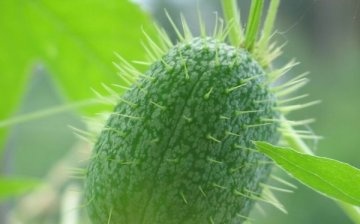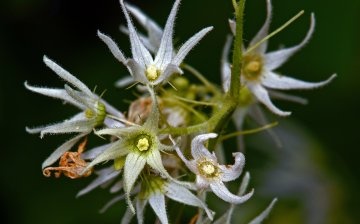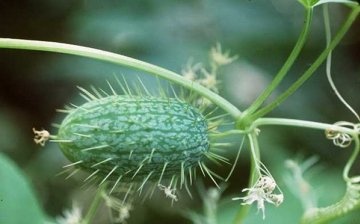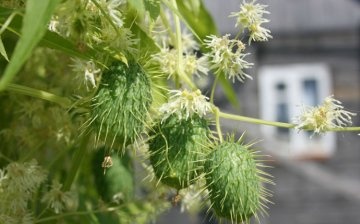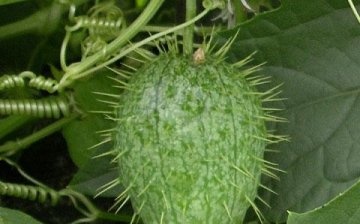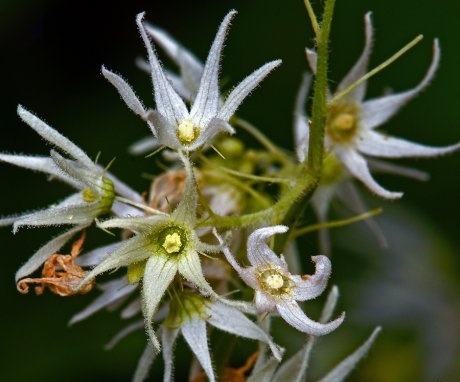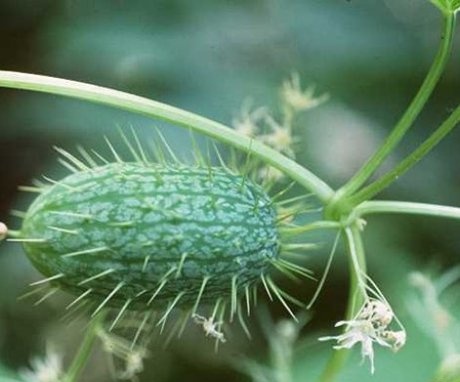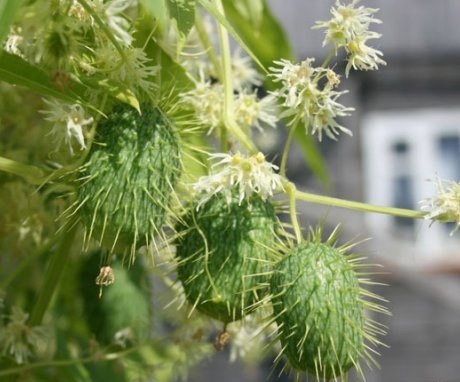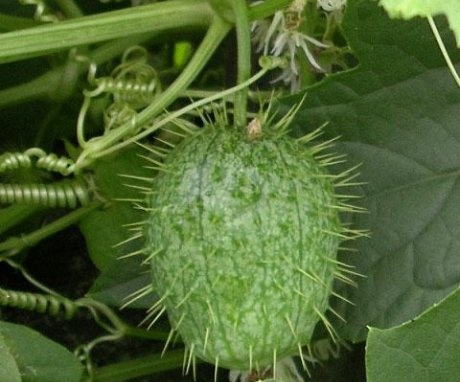Wild cucumber: growing rules and methods of application
Wild cucumber is a well-known plant. It can often be seen in coastal thickets, on wastelands. But now it is increasingly used to create hedges.
Content:
Wild cucumber: description
Wild cucumber, or lobed echinocystis, is an annual plant. It belongs to the pumpkin family.
Features of the structure of the plant:
- This is liana, the stem of which reaches 6 m. With the help of antennae, he quickly crawls up, using any support.
- The leaves of the wild cucumber are similar to the leaves of the real one. They are light green, slightly rough, cut-lobed. The number of blades can be different: three, five or seven.
- The antennae with which the plant clings to the support are modified leaves. Stems are juicy, pubescent, branched. Liana, her antennae, which looks very delicate and fragile, in fact turns out to be very strong.
- In June, the wild cucumber liana is covered with flowers. They are same sex. The female flowers are single or in pairs, the male flowers are white-green, collected in fragrant inflorescences. Each has six petals. Flowers are located in the leaf axil. Bloom lasts until September.
- The fruits (pumpkin) are also at first similar to cucumber, only more rounded, and their thorns are much larger than those of the familiar cucumber. Hence another name for echinocystis - prickly fruit. They begin to ripen in August. Gradually, their color changes from gray-green to brown. The peel from the soft watery melts tough. Inside each fruit, in two nests, there are 4 seeds, similar to pumpkin seeds. Color - from brown to black. After ripening, the fruit opens itself, and they fall out. If the summer was wet, then a lot of liquid accumulates inside the fruit, which shoots out along with the seeds, taking them several meters away.
The plant is widespread in mid-latitudes. For its original fruits, it received many popular names: spiny cucumber (from the word needle), shooting ivy (its leaves look like leaves ivy), bubble worm.
The homeland of echinocystis is North America.
In the last century, he came to Europe with the help of collectors of original plants. It was first grown in European botanical gardens. Then he settled down in nature, even went wild in many places. Now it is distributed almost throughout Europe and Russia. The name echinocystis comes from the Greek words for hedgehog and bubble. We can say that this is a spiky, like a hedgehog, bubble.
Growing wild cucumber
Wild cucumber loves well-lit areas. It grows in shaded, but weakly, forms few leaves, does not bloom and does not form fruit. The soil should be loose, air and water permeable. Grows poorly on acidic soils. Therefore, liming should be applied in such areas. It can also grow on stony soil as long as it is moist enough.
It can grow even in swampy areas, but you need to arrange drainage under root system... Echinocystis is sown in early spring. You can add to the soil fertilizers... The seeds are not afraid of frost. Return frosts to seedlings and young shoots are not terrible. Seedlings that emerged from seeds sown last year can be thinned out or transplant to a new location.
Wild cucumber does not like heat and drought and grows well in areas with a temperate climate and humidity.
Watering, bring about 5 liters of water under one plant at a time. The plant does not require special care, because it quickly outstrips its neighbors in growth, which could drown it out. Having risen above the surrounding plants, the wild cucumber receives enough sunlight to help it develop. Weeds around should be removed rather for decorative purposes.
You don't need to prune the plant because it is grown to create dense hedges. Seeds, which shoot at a speed of 11 m / s, are carried within a radius of 8 m. They fell to the ground and will sprout next spring. But only where the soil is free of weeds.
It is not recommended to grow a prickly plant in one place for several years. There is no need to treat wild cucumber with chemicals. He is not affected by any disease. There are no pests that can harm it. This promotes the spread of the plant.
Application
Wild cucumber is used:
- For vertical gardening of premises.
- For draping fences.
- For landscaping balconies.
- Like a honey plant.
For drapery of buildings and fences, wild cucumber has been used since the middle of the 19th century. He came to us in the 70s of the last century. It was widely used for landscaping public places. Its advantage is rapid growth, unpretentiousness in cultivation. It quickly and tightly braids any support with a height of 3 m or more. In addition, this support becomes quite attractive both during flowering and when it is covered with hedgehog fruits. They do not lose their rounded shape until autumn. In winter, under the influence of rain and wind, the stems of the plant gradually droop, and the balls of fruits cling with thorns to other trees or bushes and continue to hang on them until spring.
You can grow a wild cucumber on the balcony - over the summer it will grow green mass and create an original green garland.
Young fruits of the wild cucumber can be eaten. They taste like a real cucumber. Contain potassium and calcium salts. There are pectins in the fruit, enzymes useful for the body. Wild cucumber seeds can be eaten in the same way as pumpkin seeds. There is evidence that echinocystis is used in North America to brew bitter tea, which relieves headaches. But in Europe, its medicinal properties have not been studied. It was also used as a love potion.
Growing precautions
In recent years, wild cucumber has become a fairly popular herb again. But, when sowing it, you need to remember that this plant has a tendency to quickly go beyond the territory assigned to it by its owners. Seeds it spreads over long distances, germinates well. If they are not noticed in time, then uncontrolled growth can begin. In many regions, plots with unauthorized proliferation of thorns occupy a large area. In some European countries, echinocystis is considered a weed.
A wild cucumber can live with your neighbors, and there is no guarantee that they will like this purchase. Therefore, it is better to sow it from the outside of the fence, from the street side. There should be no garden beds nearby, especially neighboring ones.
However, talking about a wild cucumber as a dangerous weed is an exaggeration, its shoots are easily removed in a young period.
It is enough to cut the stem of the plant to make it dry. Its roots completely disappear in winter. Therefore, you do not need to dig them out to remove them. In addition, seeds will germinate only on moist, loose soil.
Children like wild cucumber balls. In the summer, they construct various figurines from them. Thanks to the large number of thorns, while still soft, it is quick and convenient to connect them to each other. But in the fall, the thorns become tough. Each touch of gentle children's hands to them threatens with a splinter. Some gardeners suggest picking wild cucumber fruits before they are ripe.But this idea is unlikely to be realized if you have more than one vine growing in your garden.
More information can be found in the video:



